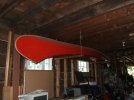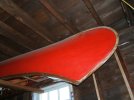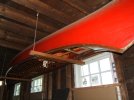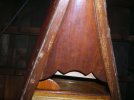Charles I. Francis
New Member
I have an Old Town Molitor model canoe that I was given in the middle 1950’s. It had some problems: one or two broken ribs that caused a slight bulge in the bottom; damage to the attachment of the ribs to the foredeck causing two or three ribs to not be secured; the canvas was in very bad shape; the varnish was really thick and black; and the gunwale caps, stem and keel were very beat up.
In my teen age ignorance, I repaired the canoe as follows: I removed the canvass, striped all the varnish and re varnished the interior; I fastened a mahogany block under the foredeck and reattached the ribs; and I fiber-glassed the canoe (amateur job.
In 1964, I brought the canoe to the Old Town factory to have new mahogany gunwale caps, new white oak stems and keel, and brass half-round on the fore and aft stems, a new caned seat and new thwarts. A Mr. Gray, who I believe was president of Old Town, came down to meet me on Memorial Day weekend to let me drop off the canoe. He took one look at it and said he thought they still they had the frames for this model up in the attic. He took me inside the office and looked in their records. He said they did not start keeping records until serial number 1000, which was in 1905. The serial number of my canoe is 560! And he showed me several old catalogs from the 1920’s or 1930’s of the Molitor model, most with Indian motif decoration as I recall.
They made the repairs, I retrieved the canoe, and I still have it but it has seen very little use since, always stored inside in very dry conditions.
A few years after my 1964 visit, Old Town began making the Molitor model again. I have always thought my canoe was the impetus for the model’s revival.
One possible discrepancy: My canoe is 16 ft. The keel is embossed “560 16.” Old Town’s revived Molitor model was 17 feet long. I suppose it’s possible my canoe was made by someone other than Old Town. I know the canoe was one of several of the same model originally owned by YMCA Camp MI-TE-NA in Alton, New Hampshire.
Can this canoe be stripped of the fiberglass and restored? How much would it cost to do that, or how much is it worth to someone that would do that?
Thank you.
Charles I. Francis
In my teen age ignorance, I repaired the canoe as follows: I removed the canvass, striped all the varnish and re varnished the interior; I fastened a mahogany block under the foredeck and reattached the ribs; and I fiber-glassed the canoe (amateur job.
In 1964, I brought the canoe to the Old Town factory to have new mahogany gunwale caps, new white oak stems and keel, and brass half-round on the fore and aft stems, a new caned seat and new thwarts. A Mr. Gray, who I believe was president of Old Town, came down to meet me on Memorial Day weekend to let me drop off the canoe. He took one look at it and said he thought they still they had the frames for this model up in the attic. He took me inside the office and looked in their records. He said they did not start keeping records until serial number 1000, which was in 1905. The serial number of my canoe is 560! And he showed me several old catalogs from the 1920’s or 1930’s of the Molitor model, most with Indian motif decoration as I recall.
They made the repairs, I retrieved the canoe, and I still have it but it has seen very little use since, always stored inside in very dry conditions.
A few years after my 1964 visit, Old Town began making the Molitor model again. I have always thought my canoe was the impetus for the model’s revival.
One possible discrepancy: My canoe is 16 ft. The keel is embossed “560 16.” Old Town’s revived Molitor model was 17 feet long. I suppose it’s possible my canoe was made by someone other than Old Town. I know the canoe was one of several of the same model originally owned by YMCA Camp MI-TE-NA in Alton, New Hampshire.
Can this canoe be stripped of the fiberglass and restored? How much would it cost to do that, or how much is it worth to someone that would do that?
Thank you.
Charles I. Francis








